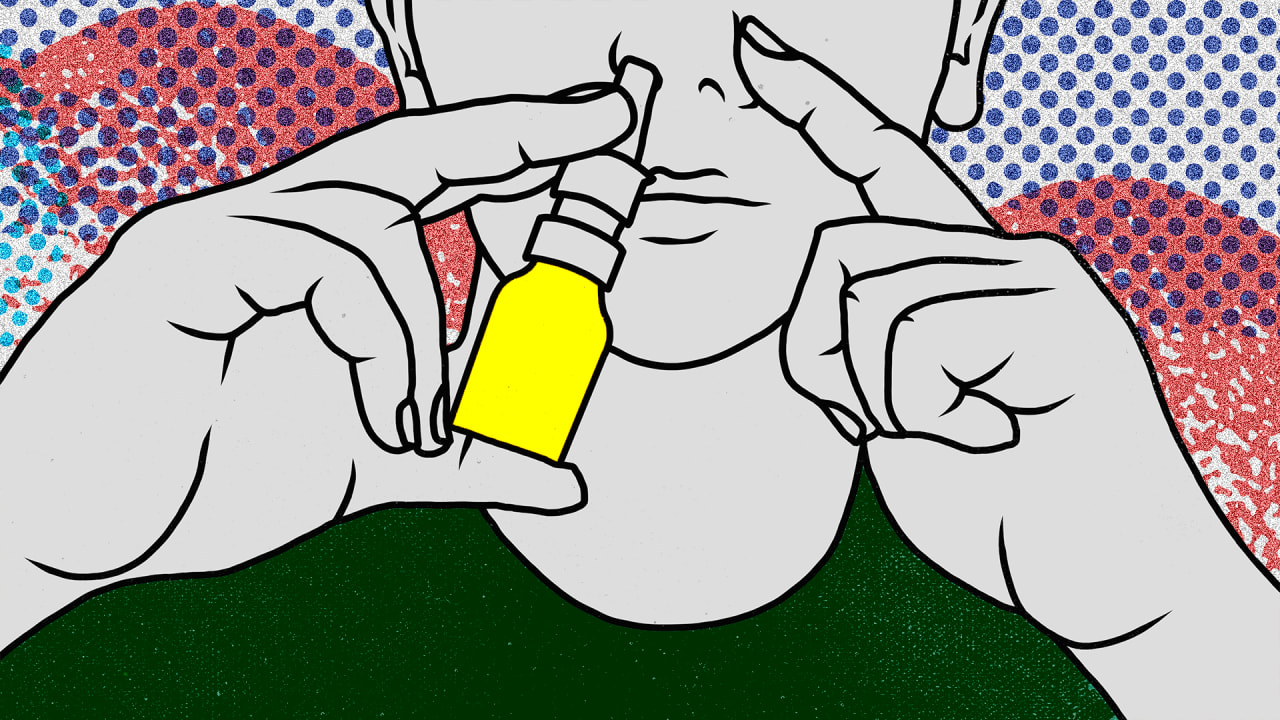Why do we have to wait so long for a COVID-fighting nasal spray?
The COVID-19 vaccines that we now have are very good at blunting the impact of the virus once it enters the body, preventing serious illness and death. But fast-spreading newer strains, such as delta and omicron, have brought renewed calls for development of vaccines that can do more—that can stop the virus as it attempts to enter the body, keeping an individual’s viral load extremely low, and drastically reducing their ability to transmit COVID -19 to someone else. Instead of a jab in the arm, these vaccines would be administered as a nasal spray. Currently, there are a dozen intranasal COVID-19 vaccines at some stage of human clinical trials, and more than 30 in preclinical studies in animals. As COVID-19 cases begin to creep back, many are wondering: When are these nasal sprays coming? The frustrating answer: You’ll probably have to wait a couple more years to get yours. But the effort to improve intranasal vaccines could have far-reaching impact beyond COVID-19, too—offering better protection against an array of respiratory viruses, including seasonal flu, which caused hundreds of thousands of hospitalizations and between 12,000 to 52,000 deaths annually in the U.S. between 2010 and 2020. Here’s what’s involved, and why the process is taking longer than developing the COVID-19 jabs. The idea behind intranasal vaccines is pretty simple. They train your body to stop viruses, such as COVID-19, “at the front door”—in the mucous membranes of the nasal passages and respiratory tract, where they enter the body. While intramuscular injections of mRNA-based vaccines have been highly effective at inducing systemic immunity—high levels of antibodies, memory B cells, and “killer” T cells circulating through the body—their effectiveness wanes over time. And they fail to induce strong immunity in the sites of infection—the nose and respiratory tract—leaving you vulnerable to a new infection. That’s where an intranasal booster would come in. Some studies have shown that priming with an injectable vaccine and following it with an intranasal booster offers systemic immunity that’s similar to traditional multi-shot booster regimens, but with enhanced immunity in the respiratory tract. That’s particularly powerful in stopping the spread of a virus, says Mark Saltzman, a professor of biomedical engineering at Yale University and cofounder of startup Xanadu Bio, which is developing an mRNA-based intranasal COVID-19 vaccine. “One of the things that mucosal immunity does that systemic immunity doesn’t do as well,” explains Saltzman, “is to create a particular kind of antibody called secretory IgA—antibodies that are very good at trapping pathogens on a mucosal surface before the pathogen can enter the body, providing a much more potent means of viral neutralization before you can become infected.” Successfully delivering vaccines through people’s noses, though, has proven really difficult in practice. One key problem is that the extra ingredients, called adjuvants, that are commonly used to increase the effectiveness of injected vaccines, are often less well tolerated when they are administered through inhalation, leading to potential adverse effects. One intranasal flu vaccine introduced in Switzerland in 2000 was withdrawn after 46 cases of Bell’s palsy were reported in recipients, likely caused by the adjuvant. (The only currently FDA-approved nasal vaccine of any type, AstraZeneca’s FluMist, uses a different formulation.) The majority of intranasal COVID-19 vaccines now in development are so-called viral vector vaccines that, similar to Johnson & Johnson’s vaccine, use the “shell” of harmless virus to deliver viral antigens. Saltzman and his colleague Akiko Iwasaki, an immunologist at Yale’s School of Medicine, have taken a different path, developing two versions of a intranasal vaccine—one that uses a COVID-19 spike protein engineered to activate an immune response without any adjuvant, and one that uses messenger RNA encapsulated in a specialized polymer that Saltzman had been working on for nearly a decade as a way to deliver gene therapy. In a preprint study published in January, they demonstrated that both vaccines, when administered to mice, activated new immune memory in the respiratory mucus tissue and enhanced systemic immunity, as well. Next up: getting approval for studies in nonhuman primates, then people. The fact that similar polymer delivery systems for controlled release of drugs have been approved by the FDA for more than a decade is encouraging, says Saltzman—and using them in an mRNA vaccine is a logical next step. “It’s not so different to make these polymer nanoparticles than it is to make the lipid nanoparticles that Pfizer or Moderna uses [to encapsulate mRNA] in their COVID vaccines,” he says. “They have scaled up so successfully, and I think we’ll be able to take advantage of that expertise for manufacturing.” The experience that regulators now have with mRNA vaccines could also help to fast-

The COVID-19 vaccines that we now have are very good at blunting the impact of the virus once it enters the body, preventing serious illness and death. But fast-spreading newer strains, such as delta and omicron, have brought renewed calls for development of vaccines that can do more—that can stop the virus as it attempts to enter the body, keeping an individual’s viral load extremely low, and drastically reducing their ability to transmit COVID -19 to someone else. Instead of a jab in the arm, these vaccines would be administered as a nasal spray.
Currently, there are a dozen intranasal COVID-19 vaccines at some stage of human clinical trials, and more than 30 in preclinical studies in animals. As COVID-19 cases begin to creep back, many are wondering: When are these nasal sprays coming? The frustrating answer: You’ll probably have to wait a couple more years to get yours. But the effort to improve intranasal vaccines could have far-reaching impact beyond COVID-19, too—offering better protection against an array of respiratory viruses, including seasonal flu, which caused hundreds of thousands of hospitalizations and between 12,000 to 52,000 deaths annually in the U.S. between 2010 and 2020. Here’s what’s involved, and why the process is taking longer than developing the COVID-19 jabs.
The idea behind intranasal vaccines is pretty simple. They train your body to stop viruses, such as COVID-19, “at the front door”—in the mucous membranes of the nasal passages and respiratory tract, where they enter the body. While intramuscular injections of mRNA-based vaccines have been highly effective at inducing systemic immunity—high levels of antibodies, memory B cells, and “killer” T cells circulating through the body—their effectiveness wanes over time. And they fail to induce strong immunity in the sites of infection—the nose and respiratory tract—leaving you vulnerable to a new infection.
That’s where an intranasal booster would come in. Some studies have shown that priming with an injectable vaccine and following it with an intranasal booster offers systemic immunity that’s similar to traditional multi-shot booster regimens, but with enhanced immunity in the respiratory tract. That’s particularly powerful in stopping the spread of a virus, says Mark Saltzman, a professor of biomedical engineering at Yale University and cofounder of startup Xanadu Bio, which is developing an mRNA-based intranasal COVID-19 vaccine. “One of the things that mucosal immunity does that systemic immunity doesn’t do as well,” explains Saltzman, “is to create a particular kind of antibody called secretory IgA—antibodies that are very good at trapping pathogens on a mucosal surface before the pathogen can enter the body, providing a much more potent means of viral neutralization before you can become infected.”
Successfully delivering vaccines through people’s noses, though, has proven really difficult in practice. One key problem is that the extra ingredients, called adjuvants, that are commonly used to increase the effectiveness of injected vaccines, are often less well tolerated when they are administered through inhalation, leading to potential adverse effects. One intranasal flu vaccine introduced in Switzerland in 2000 was withdrawn after 46 cases of Bell’s palsy were reported in recipients, likely caused by the adjuvant. (The only currently FDA-approved nasal vaccine of any type, AstraZeneca’s FluMist, uses a different formulation.)
The majority of intranasal COVID-19 vaccines now in development are so-called viral vector vaccines that, similar to Johnson & Johnson’s vaccine, use the “shell” of harmless virus to deliver viral antigens. Saltzman and his colleague Akiko Iwasaki, an immunologist at Yale’s School of Medicine, have taken a different path, developing two versions of a intranasal vaccine—one that uses a COVID-19 spike protein engineered to activate an immune response without any adjuvant, and one that uses messenger RNA encapsulated in a specialized polymer that Saltzman had been working on for nearly a decade as a way to deliver gene therapy. In a preprint study published in January, they demonstrated that both vaccines, when administered to mice, activated new immune memory in the respiratory mucus tissue and enhanced systemic immunity, as well. Next up: getting approval for studies in nonhuman primates, then people.
The fact that similar polymer delivery systems for controlled release of drugs have been approved by the FDA for more than a decade is encouraging, says Saltzman—and using them in an mRNA vaccine is a logical next step. “It’s not so different to make these polymer nanoparticles than it is to make the lipid nanoparticles that Pfizer or Moderna uses [to encapsulate mRNA] in their COVID vaccines,” he says. “They have scaled up so successfully, and I think we’ll be able to take advantage of that expertise for manufacturing.” The experience that regulators now have with mRNA vaccines could also help to fast-track the FDA approval process. “Our plan is to move quickly and follow the sort of pathway that was used for the intramuscular vaccines,” Saltzman says.
Something like Operation Warp Speed, aimed at the development of more effective boosters, “could make a difference” in getting intranasal vaccines to market sooner, says Saltzman. But don’t hold your breath. “We’d still be waiting for a COVID vaccine if all proceeded normally,” says Dr. Eric Topol, a cardiologist, author, and professor of molecular medicine at Scripps Research in San Diego. “The nasal vaccines have gotten no such aggressive support. Operation Warp Speed was a one-off, unfortunately, while COVID-19 marches on” to 2023 and beyond. Most experts foresee a more typical development timeline for intranasal vaccines, meaning approval could still be two, three, or more years out.
“We want to go fast enough to be relevant,” Saltzman says, “but slow enough to establish this as a platform so that it can be used for lots of other purposes, too.”






















